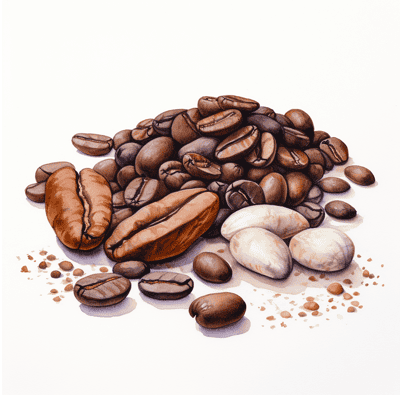
Navigating the world of cocoa beans vs coffee beans can be tricky, especially when you’re trying to make the best choice for your health and beauty. I’ll show you how to choose the best option for yourself.
Hi, I’m Hazel
I gave up on skincare after years of issues with acne and sensitive skin.
But after going plant-based, my skin cleared up and even started to glow. Now I help women reveal their natural beauty with simple, delicious plant-based food.
I also used to be a nurse, and love nerding out on nutritional science (high-quality science, that is).

As usual, this post is based on the strongest nutritional evidence I could find with a focus on the simplest, most delicious foods
…because who has time to waste on actions that don’t work?
The quick version:
Cocoa and coffee beans offer distinct health and beauty benefits. Cocoa is renowned for its skin-enhancing properties and cardiovascular benefits, attributed to its high flavanol content, while coffee is celebrated for improving cognitive function and potentially aiding in hair growth due to its rich antioxidant and caffeine content.
What Are Cocoa and Coffee Beans?
Coffee and cocoa beans are staples in many of our favourite treats and morning rituals, but they come from very different plants and have unique benefits.

Cocoa Beans: A Sweet Origin
Cocoa beans are the seeds from cocoa pods, primarily used to make cocoa powder and hot cocoa.
These beans are harvested from the cocoa tree, which thrives in the warm climates of regions like West Africa and South America.
Coffee Beans: Energising the World
On the other hand, coffee beans are the seeds of coffee cherries that grow on coffee plants.
Before becoming the cup of coffee we all love, these beans undergo a fascinating transformation, involving coffee roasters who expertly bring out the rich flavours.
Green coffee beans are known for their slightly bitter taste, which becomes more pronounced in darker roasts.
Which Tastes Better?
Both cocoa and coffee beans offer distinct flavours that can cater to different preferences. Here’s how to decide based on what your taste buds are craving.

Cocoa Beans: Rich and Chocolatey
If you love the rich, comforting taste of chocolate, cocoa beans are your go-to.
Used primarily in making cocoa powder and hot cocoa, these beans produce a smooth and often slightly sweet flavour profile that’s perfect for those who prefer less bitterness.
Cocoa pods contribute to a variety of chocolate products, from dark to milk chocolate, allowing for versatility in how you enjoy them.
Coffee Beans: Bold and Aromatic
For those who appreciate a robust and energising flavour, coffee beans deliver.
The taste of a cup of coffee can range from slightly bitter and acidic to smooth and nutty, depending on the roasting process and the type of bean.
Green coffee beans are known for their sharper flavour profile, which transforms as they are roasted into darker roasts known for their boldness.
Whether it’s a morning black coffee or an afternoon espresso, coffee offers a complex taste that can be tailored to your liking through different brewing methods and roasts.
Experimenting with Blends and Brews
Don’t hesitate to experiment with various blends and brews. Many coffee shops offer a range of options from single-origin to blended beans, giving you a chance to explore different flavour notes.
Similarly, experimenting with adding different spices or sweeteners to your hot cocoa can enhance your drinking experience, making each sip uniquely satisfying.
Beauty Benefits

Let’s explore how cocoa and coffee enhance your beauty routine through their skin and hair benefits:
Cocoa: The Anti-Aging Champion
Wrinkle Reduction: Regular consumption of cocoa powder in a hot drink like hot chocolate significantly reduces wrinkle depth and improves skin elasticity.
Skin Protection: High levels of flavanols in cacao beans protect the skin from UV damage, reducing redness and enhancing overall skin health.
Enhanced Hydration and Texture: Cacao nibs and cocoa powder, derived from raw beans, provide essential nutrients that improve skin hydration, thickness, and density.
Coffee: The Pigment Fighter and Hair Booster
Skin Pigmentation: Coffee, known as the most popular drink among coffee drinkers, contains melanoidin that fights skin pigmentation and promotes a clearer complexion.
Hair Growth Potential: The caffeine content in coffee may stimulate hair follicles, potentially promoting hair growth and health.
Skin Renewal: The amount of caffeine in your daily coffee can activate autophagy, enhancing skin renewal and maintaining a healthy glow.
Beauty Benefits Winner
For enhancing beauty, cocoa stands out with its powerful skin health benefits and anti-ageing properties.
Wellness Benefits of Cocoa and Coffee
Now let’s delve into how each bean supports overall health, with specific benefits for cardiovascular health and mental clarity.

Cocoa: Your Heart and Skin Guardian
Cardiovascular Health: Cacao beans are excellent for lowering blood pressure and reducing the risk of cardiovascular disease due to their potent antioxidant profile.
UV Protection: Daily intake of cocoa provides increased protection from UV light, aiding in skin health maintenance.
Mood and Cognitive Function: The rich flavanol content in cacao enhances both mood and cognitive function, making it a powerful hot drink choice.
Coffee: The Gut Health and Longevity Enhancer
Digestive Health: Coffee, available at most grocery stores, increases Bifidobacteria in the gut, improving overall digestive health.
Longevity Features: Regular coffee drinkers may benefit from coffee’s ability to promote longer telomeres, linked to longevity.
Cognitive Boost: Different types of beans offer varying levels of caffeine content, which can enhance global cognitive function without the caffeine jitters often associated with much caffeine.
Health Benefits Winner
While both beans offer substantial health benefits, cocoa is particularly effective for cardiovascular health and mood enhancement, whereas coffee excels in digestive health and cognitive support.
From Bean to Brew: Processing Cocoa and Coffee
Understanding how cocoa and coffee beans are prepared and processed can give insight into their unique flavours and health benefits. Let’s explore the journey of each bean from raw ingredient to your cup.
Cocoa: Rich and Versatile
Starting with the Cacao Pod
Cocoa production begins with cacao pods harvested in tropical climates. The beans inside these pods undergo a crucial fermentation process, which is essential for flavour development.
Creating Cocoa Products
After fermentation, cocoa beans are dried, roasted at high temperatures, and then separated into cocoa solids and cocoa butter. The solids are ground into cacao powder, a versatile ingredient used in everything from baking to hot drinks.
The Role of Cocoa Butter
Cocoa butter, extracted during the processing, is a key component in chocolate production, adding richness and texture to the finished product.
Coffee: Aromatic and Complex
Harvesting at Higher Altitudes: Coffee beans, typically grown in higher altitudes, are picked from the coffee plant as whole beans encased in cherries.
Processing for Perfection: The beans are extracted from the cherries and undergo a similar process of fermentation, which enhances their aromatic compounds. This step is crucial for developing the deep, complex flavours coffee is known for.
Roasting to Brewing: Post-fermentation, coffee beans are roasted at high temperatures to bring out their full flavour profile. They can be ground for use in coffee makers, prepared in a French press, or even served as instant coffee for a quicker finished brew.
Key Takeaways
Both cocoa and coffee undergo meticulous processing steps that transform the raw beans into the flavourful and health-beneficial products we enjoy.
The careful handling of each raw ingredient—from the fermentation process to roasting—ensures that the final products deliver the best in taste and quality, whether it’s a rich cocoa powder drink or a robust cup of coffee made in your favourite French press.
Each step, from the cacao pod to the finished brew, plays a critical role in creating the beverages loved worldwide.
Environmental and Ethical Considerations
Making informed choices about what we consume goes beyond just health; it also touches on the environment and ethical sourcing. Let’s consider how cocoa and coffee beans stack up in these crucial areas.
Sustainability in Bean Production
Growing cacao plants and coffee plants has significant environmental impacts, depending on how they are cultivated.
Sustainable practices in farming can help preserve ecosystems and ensure that farming methods do not harm local communities or wildlife.
Ethical Sourcing: More Than Just Taste
When it comes to coffee cherries and cocoa pods, the conditions under which they are harvested matter greatly.
Ethical sourcing ensures that workers are treated fairly and that farming practices are both environmentally and socially responsible. By choosing products from companies that prioritise these practices, you’re supporting a healthier planet and fairer trade conditions.
Cocoa beans vs Coffee beans
Understanding the main differences between cocoa beans vs coffee beans involves more than comparing taste—it’s about considering their health benefits, environmental impact, and ethical sourcing. Whether you lean towards a soothing cup of coffee or prefer the rich flavour of hot cocoa, knowing more about what goes into your cup can help you make choices that align with your health goals and moral values. Keep exploring to find the perfect bean that not only delights your taste buds but also supports a sustainable and ethical lifestyle.
References
Most references below will link to the original peer-reviewed study itself. However, sometimes I will link to a video over at NutritionFacts.org instead, which is by far the single best resource of brutally transparent nutritional evidence you will ever see. Dr Greger tells a great story about the realities of the science and if I think you will benefit more from one of his videos, the link will take you there instead.
Happy nerding!
- Miller KB, Hurst WJ, Payne MJ, et al. Impact of alkalization on the antioxidant and flavanol content of commercial cocoa powders. J Agric Food Chem. 2008;56(18):8527-8533. doi:10.1021/jf801670p
- Vázquez-Agell M, Urpi-Sarda M, Sacanella E, et al. Cocoa consumption reduces NF-κB activation in peripheral blood mononuclear cells in humans. Nutr Metab Cardiovasc Dis. 2013;23(3):257-263. doi:10.1016/j.numecd.2011.03.015
- Neukam K, Stahl W, Tronnier H, Sies H, Heinrich U. Consumption of flavanol-rich cocoa acutely increases microcirculation in human skin. Eur J Nutr. 2007;46(1):53-56. doi:10.1007/s00394-006-0627-6
- Heinrich U, Neukam K, Tronnier H, Sies H, Stahl W. Long-term ingestion of high flavanol cocoa provides photoprotection against UV-induced erythema and improves skin condition in women. J Nutr. 2006;136(6):1565-1569. doi:10.1093/jn/136.6.1565
- Yoon HS, Kim JR, Park GY, et al. Cocoa Flavanol Supplementation Influences Skin Conditions of Photo-Aged Women: A 24-Week Double-Blind, Randomized, Controlled Trial. J Nutr. 2016;146(1):46-50. doi:10.3945/jn.115.217711
- Malakar, Sreepurna & Gibson, Peter & Barrett, Jacqueline & Muir, Jane. (2016). Naturally Occurring Dietary Salicylates: A Closer Look at Common Australian Foods. Journal of Food Composition and Analysis. 57. 10.1016/j.jfca.2016.12.008.
- Neshatdoust, S., Saunders, C., Castle, S. M., Vauzour, D., Williams, C., Butler, L., Lovegrove, J. A., & Spencer, J. P. (2016). High-flavonoid intake induces cognitive improvements linked to changes in serum brain-derived neurotrophic factor: Two randomised, controlled trials. Nutrition and healthy aging, 4(1), 81–93. https://doi.org/10.3233/NHA-1615
- Fukushima Y, Takahashi Y, Hori Y, et al. Skin photoprotection and consumption of coffee and polyphenols in healthy middle-aged Japanese females. Int J Dermatol. 2015;54(4):410-418. doi:10.1111/ijd.12399
- Morales FJ, Somoza V, Fogliano V. Physiological relevance of dietary melanoidins. Amino Acids. 2012;42(4):1097-1109. doi:10.1007/s00726-010-0774-1
- Wanke V, Cameroni E, Uotila A, et al. Caffeine extends yeast lifespan by targeting TORC1. Mol Microbiol. 2008;69(1):277-285. doi:10.1111/j.1365-2958.2008.06292.x
- Sinha RA, Farah BL, Singh BK, et al. Caffeine stimulates hepatic lipid metabolism by the autophagy-lysosomal pathway in mice. Hepatology. 2014;59(4):1366-1380. doi:10.1002/hep.26667
- Pietrocola F, Malik SA, Mariño G, et al. Coffee induces autophagy in vivo. Cell Cycle. 2014;13(12):1987-1994. doi:10.4161/cc.28929
- Massolt ET, van Haard PM, Rehfeld JF, Posthuma EF, van der Veer E, Schweitzer DH. Appetite suppression through smelling of dark chocolate correlates with changes in ghrelin in young women. Regul Pept. 2010;161(1-3):81-86. doi:10.1016/j.regpep.2010.01.005
- Jaquet M, Rochat I, Moulin J, Cavin C, Bibiloni R. Impact of coffee consumption on the gut microbiota: a human volunteer study. Int J Food Microbiol. 2009;130(2):117-121. doi:10.1016/j.ijfoodmicro.2009.01.011
- Mehrabani S, Arab A, Mohammadi H, Amani R. The effect of cocoa consumption on markers of oxidative stress: A systematic review and meta-analysis of interventional studies. Complement Ther Med. 2020;48:102240. doi:10.1016/j.ctim.2019.102240
- Serafini M, Bugianesi R, Maiani G, Valtuena S, De Santis S, Crozier A. Plasma antioxidants from chocolate. Nature. 2003;424(6952):1013. doi:10.1038/4241013a
- Poole R, Kennedy OJ, Roderick P, Fallowfield JA, Hayes PC, Parkes J. Coffee consumption and health: umbrella review of meta-analyses of multiple health outcomes [published correction appears in BMJ. 2018 Jan 12;360:k194]. BMJ. 2017;359:j5024. Published 2017 Nov 22. doi:10.1136/bmj.j5024
- Duarte GS, Farah A. Effect of simultaneous consumption of milk and coffee on chlorogenic acids’ bioavailability in humans [published correction appears in J Agric Food Chem. 2011 Oct 12;59(19):10772]. J Agric Food Chem. 2011;59(14):7925-7931. doi:10.1021/jf201906p